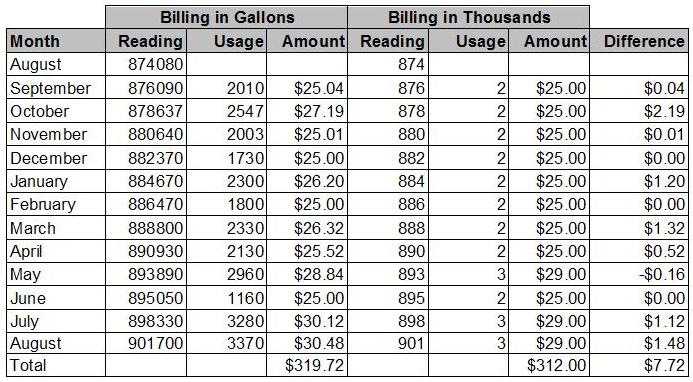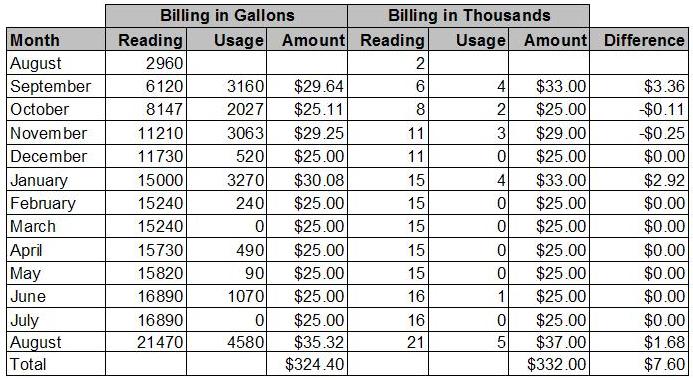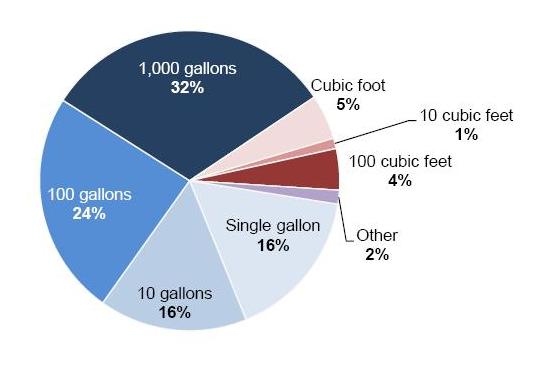Last week I had an interesting conversation with a customer who was dealing with an irate customer of hers who had taken his complaint before the board. It seems that this gentleman was upset because he thought the utility was billing him incorrectly. So, what were they doing wrong…? Billing him in thousands of gallons, so he contended!
Our customer had to prepare a response to her board and had two questions:
- What would be involved in changing from billing in thousands of gallons to billing in actual gallons?
- How many other utilities bill in thousands of gallons?
Billing in gallons as compared to thousands of gallons
We discussed the issue for a few minutes and she had a good grasp of the difference between billing in thousands of gallons and billing in gallons. Namely, when billing in thousands, the customer is the beneficiary of a deferred billing for any usage until the meter rolls to the next thousand gallons. In the illustration below, the customer is only billed for 4000 gallons when the actual usage is almost 5000 gallons:

However, billing in thousands can work to the customer’s disadvantage if the previous reading was just less than the next thousand and the current reading is just more than another thousand. In this illustration, the customer is billed for 4000 gallons when the actual usage is just over 3000 gallons:

Obviously, if you are currently reading and billing in thousands of gallons, there is no way to go back and know what the actual reading was in gallons at the time the meter was read. So, unless the customer read his meter at the same time as the meter reader, there is no way he could have known if he was being billed more or less.
So, let’s conduct an experiment…
I decided to conduct an experiment using actual reading data to see what the impact of reading and billing in thousands is compared to reading and billing in gallons. Since our customer reads in thousands, there was no way I could use their data.
I happened to have actual reading data, in gallons, from another customer’s conversion a few years ago on my laptop. So I decided to use that data and calculate a year’s worth of charges using the rates of the customer who called.
Those rates are pretty straightforward – the base charge of $25.00 includes 2000 gallons and all usage over 2000 gallons is billed at $4.00/thousand gallons.
Results of the experiment…
From the sample data, I eliminated all accounts that had less than 13 months of readings. I was left with data from 698 accounts with which to conduct my experiment. Of those 698 accounts, 102 (or 14.6%) were billed the same in gallons and thousands, 312 (44.7%) were billed more in gallons and 284 accounts (40.7%) were billed more in thousands.
The total billed in gallons was $353,413.14 and the total billed in thousands was $353,404.00 for a net difference of only $9.14! The largest difference for any individual account was $7.72 when billed in gallons and $7.60 when billed in thousands:

Below is the billing detail for the account that was billed more in gallons:

Below is the billing detail for the account that was billed more in thousands of gallons:

As you can see, it’s pretty much a toss-up as to whether the customer or the utility benefits from billing in gallons or thousands. In some cases, the customer benefits and in other cases, it works to the customer’s disadvantage.
Why would a utility change billing units?
If you’re already reading and billing in gallons, I can’t think of any reason to change to a larger billing unit.
If you’re billing in thousands and considering changing to gallons, I would only recommend doing so if you have a reason other than pacifying an upset customer! The best reason I can think of is if you are moving from reading with handhelds to some form of automated meter reading, either drive-by or fixed base.
An excellent time to make the switch from billing in thousands to billing in gallons is the conversion to a new billing system.
Let’s go back and answer the original two questions from our customer…
What would be involved in changing from billing in thousands to billing in gallons?
If you were to decide to change from billing in thousands to billing in gallons, the following data fields would have to be changed for each account in your billing system:
- Previous reading
- Current reading (if readings have been updated)
- Usage (if readings have been updated)
- Any usage history used to calculate the moving average
- Moving average
- Number of dials
How many other utilities bill in thousands of gallons?
To answer this question, I turned to the 2010 North Carolina Water and Wastewater Financial Practices and Policies Survey conducted by the Environmental Finance Center at the University of North Carolina and the North Carolina League of Municipalities. This survey tallied the responses of 277 utilities across North Carolina about their financial practices and policies. Even if your utility is not located in North Carolina, this document is filled with useful and insightful information.
The following graph appears on page 3 and answers the question, “At what level does your utility round measured consumption to calculate bills?”:

As you can see, billing in thousands of gallons is the most common billing unit of the utilities surveyed. I assured our customer that her utility is on solid ground with their policy of billing in thousands of gallons.


